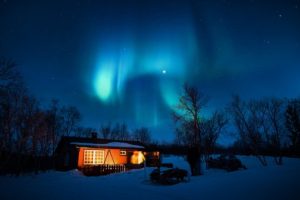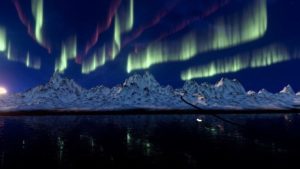There’s a huge amount of information about Northern Lights viewing available online today. Several different countries claim to provide the best viewing (and I must admit I’m a bit biased in Canada’s favour), and even after you’ve decided on a country, there’s normally a number of different towns within that country, all vying for your attention and your visit.
The main deciding factor driving the appearance of Northern Lights or Aurora is something called the Auroral Oval. This is the circle centred above the magnetic north pole (not the geographical one) which has the strongest and most frequent Aurora activity. Because of the magnetic north pole, the circle gets skewed into an oval shape and varies seasonally.
Several countries or areas of countries sit below the Auroral Oval, such as Arctic Canada (northern Manitoba, the Northwest Territories and Nunavut); Greenland, Iceland, the Faroe Islands, the northern portion of Scotland (Orkney and Shetland Islands), Norway, northern Sweden, Finland and Russia.
So, how are you supposed to decide between these countries, separate the wheat from the chaff and settle on real ‘best’ place to experience the spectacular aurora borealis for yourself? Well, as specialists in northern travel for the last 35 years, we’re happy to share a few pointers with you and get you on your way stress-free.
Like anything to do with natural phenomenon, we can’t guarantee sightings of Northern Lights. But, we’ve based our recommendations on destinations that, first and foremost, have aurora displays that are as close to reliable as possible. Next, we looked for places that are relatively accessible by commercial flights. Finally, we considered the number of other activities available – one of the things that makes hunting for aurora so exciting is their unpredictability, so having other exciting activities and experiences available means you’ll have a great trip no matter what the northern lights are doing.
So, here are three of our favourite northern lights destinations:
- Iceland
Why? There’s something in Iceland for everyone. You can enjoy the cultural vibe of unique Reykjavik, and take evening excursions to the dark-sky areas to look for the northern lights. Alternatively, a stay in a rural hotel or farmhouse means you’re in the exact right spot to see the lights when they choose to show themselves. There are regular flights into the capital, and a plethora of other activities to keep you busy. From dog-sledding to soaking in a natural hot spring, and everything in between. All in all, Iceland is a destination that offers excellent chances of seeing the elusive aurora, and has a number of other things to offer as well. Contact us, and we’ll be happy to chat with you about the best times of year to see the northern lights in Iceland. - Yellowknife and Blachford Lake Lodge, Northwest Territories
Why? Yellowknife and the area of the Northwest Territories where Blachford Lake Lodge is located sits beneath the auroral oval. Yellowknife is a vibrant, northern city that has a lot to offer visitors. Blachford Lake Lodge, which is only accessible by charter plane, despite its remote location, offers its guests a wide range of activities depending on the season. Try your hand at ice fishing, go snowshoeing or for a snowmobile ride, learn how to build an igloo or just relax in the hot tub and visit with fellow adventurers. So, even when you’re not out hunting for Aurora, you’ll still have lots to do to enjoy your time. - Norway
Why? Nearly the entire country of Norway occupies a spot right underneath the auroral oval – the zone with the best chances of seeing auroral activity. It’s a bit further to travel for North Americans than the Northwest Territories or Iceland, but has just as much to offer. Head there at the right time of year and you’ll find good chances of clear skies, essential for viewing. In Norway there are also options to take a cruise along the coast, year round, a pretty unique way to look for ‘the lights’ if you ask us!
So there you have it, three of our favourite Northern Lights destinations (but certainly not them all! I once witnessed or rather heard and then saw a band of aurora come swooshing above my head while in the south of Greenland – a sight I’ll never forget! And I’ve watched multi-coloured auroras swirl and dance overhead right here in southern Manitoba. You just never know when they might make an appearance).
Remember, looking for the aurora takes time and patience. The northern lights are caused by highly charged electrons from the sun interacting with the earth’s atmosphere. We see them around the magnetic poles, but only if the sky is clear! We cannot see northern lights through the clouds. So, we need space weather and earth weather to cooperate with each other, which can take time. Give yourself a week or so for the best chances, and good luck!










